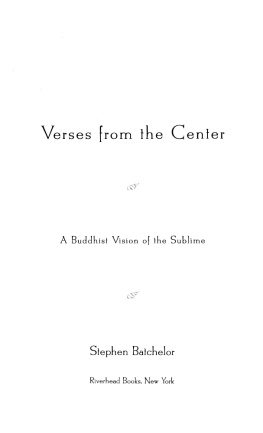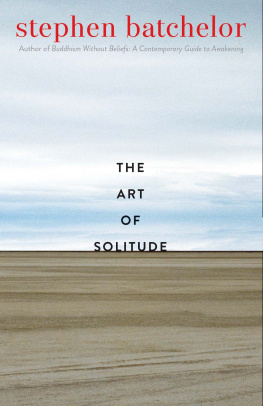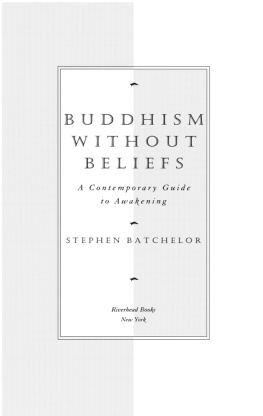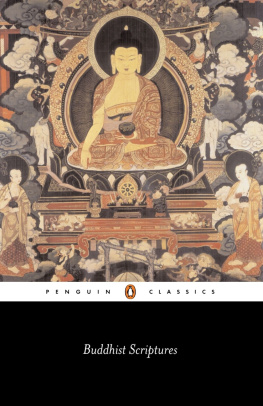Praise for Stephen Batchelors
Buddhism Without Beliefs
Radiant in its clarity, Buddhism Without Beliefs reminds us not just of Buddhisms true nature, but of our own as well. Freeing us from the notion of Buddhism as a religion, Stephen Batchelor shows us how necessary the Buddhas teachings are in todays world. It may not be what he intended, but he has made a believer out of me.
Mark Epstein, M.D.,
author of Thoughts Without a Thinker: Psychotherapy from a Buddhist Perspective
Buddhism Without Beliefs is the kind of finely written primer about the precepts of Buddhism that even a heathen like me can appreciate and understand. For the non-Buddhist, or the aspiring Buddhist, it will be of much assistance. Filled with compassion, lucidly written, this is a book that explains much about an ancient, ever-living philosophy that has much to offer the stunned searchers of truth in our chaotic age of modernity.
Oscar Hijuelos,
author of Mr. Ives Christmas and The Mambo Kings Play Songs of Love
The clarity and beauty of his presentation make Stephen Batchelors book a resource for people at any stage of spiritual life. This book is clearly the fruit of a rigorous and dedicated effort to make the truths of Buddhism workable. Batchelor, and the Buddha, will help you dust off the diamond of your own mind.
Kate Wheeler,
author of Not Where I Started From
Concise... Batchelor makes several controversial, but thoughtfully argued, points central to his existential, therapeutic and agnostic interpretation of Buddhism: that Buddhism is not strictly a religion, since it does not adhere to a belief in God; that the Buddha did not consider himself a mystic or savior, but a healer; and that Buddhism is less a belief system than a personal course of action that naturally instills morality, compassion, and inner peace in the practitioner.
Publishers Weekly
Also by Stephen Batchelor
Alone With Others: An Existential Approach to Buddhism
The Faith to Doubt: Glimpses of Buddhist Uncertainty
The Tibet Guide: Central and Western Tibet
The Awakening of the West:
The Encounter of Buddhism and Western Culture
Buddhism Without Beliefs: A Contemporary Guide to Awakening
TRANSLATIONS
A Guide to the Bodhisattvas Way of Life (Shantideva)
Echoes of Voidness (Geshe Rabten)
Song of the Profound View (Geshe Rabten)
The Mind and Its Functions (Geshe Rabten)
Verses from the Center

A Buddhist Vision of the Sublime

Stephen Batchelor

Most Riverhead Books are available at special quantity discounts for bulk purchases for sales promotions, premiums, fund-raising, or educational use. Special books, or book excerpts, can also be created to fit specific needs.
For details, write: Special Markets, The Berkley Publishing Group, 375 Hudson Street, New York, New York 10014.

RIVERHEAD BOOKS
Published by The Berkley Publishing Group
A division of Penguin Putnam Inc.
375 Hudson Street
New York, New York 10014
Copyright 2000 by Stephen Batchelor
Book design by Chris Welch
Cover design Royce M. Becker
All rights reserved. This book, or parts thereof, may not be reproduced in any form without permission.
First Riverhead hardcover edition: April 2000
First Riverhead trade paperback edition: July 2001
The Library of Congress has catalogued the Riverhead hardcover edition as follows:
Nagarjuna, 2nd cent.
[Madhyamakakarika. English]
Verses from the center : a Buddhist vision of the sublime / Stephen Batchelor.
p. cm.
ISBN: 978-1-101-66309-7
1. Mdhyamika (Buddhism)Early works to 1800. I. Batchelor, Stephen. II. Title.
BQ2792.E5 B38 2000 00-021123
294.385dc21
for Maurice Ash
The dharma taught by buddhas
Hinges on two truths:
Partial truths of the world
And truths which are sublime.
Without knowing how they differ,
You cannot know the deep;
Without relying on conventions,
You cannot disclose the sublime;
Without intuiting the sublime,
You cannot experience freedom.
Nagarjuna
Contents

Preface

I have written this book in order to elucidate the vision of the great Buddhist teacher Nagarjuna. Although Nagarjuna is arguably the most important figure in Buddhism after the Buddha himself, very little is known about him. All that can be said with any certainty is that he lived at some time around the second century C.E. in India and is the author of a Sanskrit work of 448 verses, divided into twenty-seven chapters, entitled Verses from the Center (Mlamadhyamakakrik). Yet while Nagarjuna continues to be revered today as a founding figure of many living Buddhist traditions, his seminal work is almost entirely ignored.
I have sought to translate Verses from the Center in such a way as to make Nagarjunas insights come alive for anyone concerned with the question of what it means to live a free and awake life today. Instead of regarding the text as a work of Buddhist doctrine or philosophyas is generally the case in studies of NagarjunaI treat it in the spirit of a Zen koan, which provokes intuitions of the sublime by forcibly challenging entrenched opinions about ourselves and the world.
The book begins with Intuitions of the Sublime, which locates Nagarjunas central and much-misunderstood idea of emptiness in the wider context of Buddhist, Taoist and Western traditions and offers a contemporary interpretation of Nagarjunas vision. This introductory essay is followed by a poetic translation of the Tibetan text of Verses from the Center. For a more literal, academic translation, the reader is referred to Jay L. Garfields The Fundamental Wisdom of the Middle Way: Ngrjunas Mlamadhyamakakrik. New York/Oxford: Oxford University Press, 1995.
In writing this book I am indebted to the Sharpham Trust, who have generously supported the project for the past four years. Thanks also to Paul Williams for providing a digital copy of the Tibetan text and promptly answering occasional technical questions on Sanskrit; to Gay Watson for keeping my classical Tibetan in working order; to Selima Hill for encouraging me to write poetry; to Helen Tworkov for unwavering support throughout; to Anne Edelstein for helping the book find its way into the world; to Amy Hertz for enabling the work to reach its final form; and to my wife, Mar tine, for everything.
Stephen Batchelor
December 1999
Intuitions of the Sublime

1
B EHIND THE GILDED S WAYAMBU STUPA , WHOSE PAINTED eyes gaze over the Nepalese capital of Kathmandu, is a nondescript building with a single shabby room, empty save for a bronze door smeared with vermilion powder. Tibetans believe this door leads to a cave whence a passageway descends to the subterranean lake where the Indian sage Nagarjuna was taken by a species of sub-aquatic serpents called












